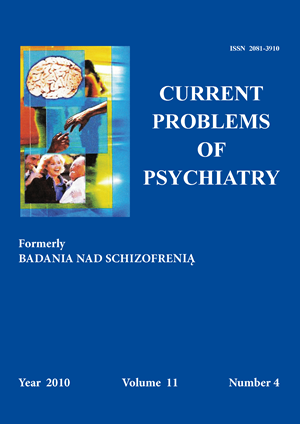Przemoc domowa – identyfikacja zjawiska. Przegląd piśmiennictwa
Słowa kluczowe:
przemoc domowaAbstrakt
Przemoc wobec członków rodziny jest zjawiskiem nader powszechnym, istnieje właściwie od zawsze i we wszystkich społeczeństwach. Od dawna też zachowania agresywne były karalne i podlegały jurysdykcji sądów. Oficjalne raporty, dane sondażowe i badania kliniczne przedstawiają wysokie stopy powszechności dla każdej formy krzywdzenia członków rodziny. Przemoc dotyka w większości kobiety i ma miejsce wszystkich warstwach społecznych, a zakorzenione w społeczeństwie postrzeganie roli kobiety prowadzi do trywializacji przemocy domowej. Szacunki dotyczące częstości występowania przemocy są różne i można tłumaczyć to na różne sposoby. Niedoszacowanie rozmiarów przemocy w rodzinie można tłumaczyć między innymi tym, iż ofiary przemocy pragną chronić integralności rodziny lub żywią przekonanie, że jest to sprawa rodziny, a wszelkie nieporozumienia powinny zostać rozwiązane wewnątrz rodziny. Często, akceptacja społeczna przemocy w rodzinie jako zjawiska naturalnego, wzmacnia lęk przed ujawnieniem faktów. Uzyskane wyniki zależą także od wielu innych czynników m.in. od zastosowanej metodologii badań, przyjętej definicji przemocy, czy źródła informacji. Rezultaty badań zależą także od przyjętej koncepcji przemocy, zastosowanych narzędzi pomiaru oraz metodologii badań.
Bibliografia
1. Seneka, De Clementia XXIV, cyt. za Filozofia starożytna Grecji i Rzymu. Warszawa: 1968.
2. Ptacek J. The tactics and strategie sof men who batter, violence between intimate partners. W: Patterns, causes and effects. Cardarelli A.P. red., Allyn & Bacon a Viacon Company; Needham Heights, MA: 1997.
3. Międzynarodowa konwencja o zwalczaniu handlu kobietami i dziećmi z 30 września 1921 Dz. U. 1925 r., Nr 125, poz.893.
4. Konwencja w sprawie likwidacji wszelkich form dyskryminacji kobiet z 18 grudnia 1979 r. Dz. U. 1982r., Nr 10, poz.71.
5. Stanko E.A., Crisp D., Hale C., Lucraft H. Counting the Costs: Estimating the Impact of Domestic Violence in the London Borough of Hackney. Crime Concern; Wiltshire: 1998.
6. Dominy N., Radford L. Domestic violence in surrey: developing an effective interagency response. Roehamptom Institute; London: 1996.
7. Field C., Caetano R. Intimate partner violence in US general population: progress and future directions. J. Interpers. Violence, 2005; 20(4): 463-469.
A.Wójcicka, A. Stodulska-Blaszke 354
8. Ernst A., Nick T., Weiss S., Houry D., Mills T. Domestic violence in an innercity ED. Ann. Emer. Med., 1997; 30(2): 190-197.
9. Bauer H., Rodriguez M., Pèrez-Stable R. Prevalence and determinants of intimate partner abuse among public hospital primary care patients. J. Gen. Intern. Med., 2000; 15: 811-817
10. Abbott J., Johnson R., Koziol-McLain J., Lowenstein S.R. Domestic violence against women. Incidence and prevalence in an emergency department population. JAMA, 1995; 273: 1763.
11. Coker A.L., Smith P.H., Bethea L., King M.R., McKeown R.E. Physical health consequences of physical and psychological intimate violence. Arch. Fam. Med., 2000; 9: 451.
12. Plichta S.B., Falik M. Prevalence of violence and its implications for women’s health. Womens Health Issues, 2001; 11; 244.
13. Straus M.A., Gelles R.J., Steinmetz S.K. Behind closed doors: Violence in American family. Anchor/Doubleday; New York: 1980.
14. White J.W., Koss M.P. Courtship violence: Incidence in national sample of higher education students. Violence and Victims, 1991; 6: 247-256.
15. McNeely R.L. Mann C.R. Domestic violence is human issue. Journal of Interpersonal Violence, 1990; 5: 129-132.
16. Frezie I.H., Browne A. Violence in marriage. W: Ohlin L., Tonry M. red., Family violence. University of Chicago Press; Chicago: 1989, s 163-218.
17. World Health Organization, Preventing violence: a guide to implementing to recommendations of the World. Report on Violence and Health; Geneva: 2004.
18. Pinheiro P.S. http://www.violencestudy.org/IMG/pdf/English.
19. Integration of human rights of women and the gender perspective violence against women.http://www.unhchr. ch/huridocda/huridoca.nsf/e06a5300f90fa0238025668700518ca4/42e7191fae543562c1256ba7004e963c/$FILE/G0210428.pdf
20. OBOP 2005 http://www.cbos.pl/SPISKOM.POL/2005/ K_027_05.PDF
21. OBOP 2007 http://www.mpips.gov.pl/index.php?gid=1518
22. bip.ms.gov.pl/pl/dzialalnosc/statystyki/statystyki.../download,731,16.html
23. bip.ms.gov.pl/pl/dzialalnosc/statystyki/statystyki-2010/
24. Błachut J., Gaberze A., Krajewski K.: Kryminologia Gdańsk 2006 s.262
25. Walker L.E. How battering happens and how stop it W: The Battered Women. Harper & Row Publishers; New York: 1979, s 59-78.
26. Weis J.G. Family violence research methodology and design. W: Ohlin L., Tonry M. red., Family violence University of Chicago Press; Chicago: 1989, s 117-162.
27. Frączek A.F. Studia nad uwarunkowaniami i regulacją agresji interpersonalnej. Wyd. „Ossolineum”; Wrocław: 1986.
28. Rodniański J. Klasyfikacja, źródła i ocena przemocy w stosunkach międzyludzkich W: Hołyst B. red., Przemoc w życiu codziennym. Warszawa: 1996, s. 5.
29. Archer J., Browne K. Concepts and approaches to the study of aggression. W: Human aggression. Naturalistic approaches. Routledge; London: 1989, s. 11.
30. Erdley C.A., Asher S.R. Linkages between children’s beliefs about the legitimacy of aggression and their behavior. Social Development, 1998; 7: 321-339.
31. O’Keefe M. Predictors of child abuse in martially violent families. J. Interpers. Violence,1995; 10: 3-25.


